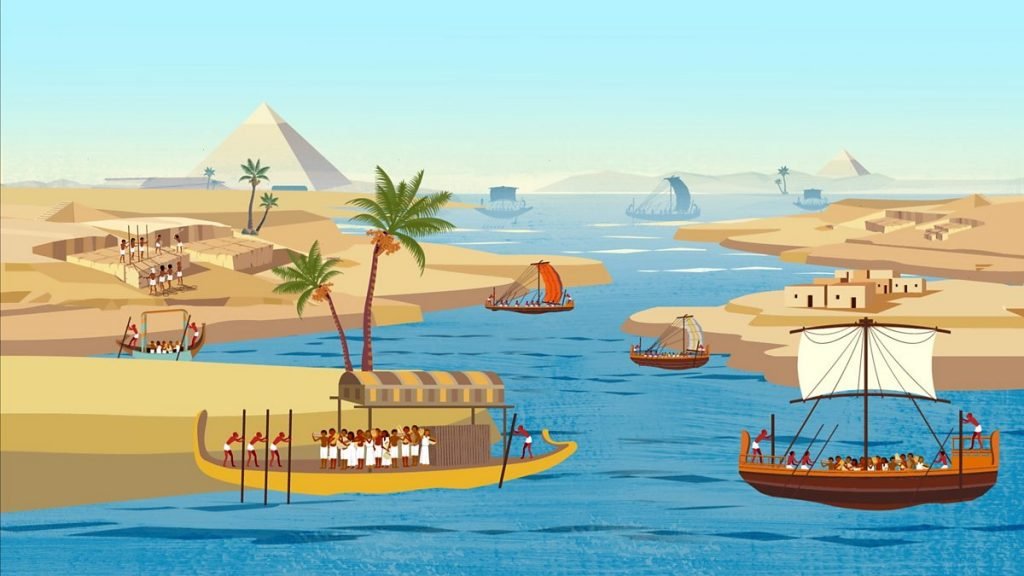When the Greek historian Herodotus stated that the ancient Egyptians’ land was given to them by the river, he was referring to the Nile, the waters of which were critical to the creation of one of the world’s earliest great civilizations. The Nile, which runs 4,160 miles north from east-central Africa to the Mediterranean, provided ancient Egypt with excellent soil and water for irrigation, as well as a way of delivering building materials. Its life-giving rivers allowed cities to develop in the midst of a desert.
People who lived along the Nile’s banks had to figure out how to deal with the river’s annual flooding in order to benefit from it. They also learned new skills and technologies, ranging from agriculture to boat and ship construction. The Nile even helped build the pyramids, the colossal marvels that are among the most visible remains of Egyptian civilization. Aside from practical considerations, the huge river had a tremendous impact on the ancient Egyptians’ perception of themselves and their world, shaping their religion and culture.
According to Lisa Saladino Haney, associate curator of Egypt at the Carnegie Museum of Natural History in Pittsburgh, the Nile was a key lifeline that literally provided life to the desert. There would be no Egypt if the Nile did not exist, Egyptologist argues in his 2012 book, The Nile.
The Nile Was a Source of Rich Farmland
The Nile’s contemporary name stems from the Greek word helios, which means river valley. The ancient Egyptians called it AR or Aur, which means black, in allusion to the rich, dark sediment carried northward by the Nile’s waters and deposited in Egypt each year as the river swamped its banks in late summer. The Nile Valley was transformed into rich farmland as a result of this influx of water and nutrients, allowing Egyptian civilization to flourish in the midst of a desert.
According to Barry J. Kemp in Ancient Egypt: Anatomy of a Civilization, the Nile Valley’s heavy coating of silt converted what might have been a geological marvel, a variant of the Grand Canyon, into a thickly populated agricultural nation. The Nile was such a focal point for the ancient Egyptians that the first month of the floods was included in their calendar. Even a deity of flooding and fertility, Happy, who was represented as a plump guy with blue or green skin, was worshipped in Egyptian religion.
Ancient Egyptian farmers were one of the first people to undertake agriculture on a big scale, according to the UN’s Food and Agriculture Organization, growing food crops like wheat and barley as well as industrial crops like flax for textile production. Ancient Egyptian farmers used a practice known as basin irrigation to make the most of the Nile’s waters. They built earthen bank networks to create basins and excavated channels to transport floodwater into the basins, where it would sit for a month until the soil was saturated and suitable for planting.
Arthur Goldschmidt Jr., a retired Penn State University Middle East history professor and author of A Brief History of Egypt, says:
“It’s obviously difficult if the land on which you’ve built your home and grown your food gets flooded by a river every August and September, as the Nile did before the Aswan High Dam. The ancient Egyptians had to use ingenuity and probably a lot of trial-and-error experimentation to build dikes, channels, and basins to transfer and store part of the Nile waters. “
The ancient Egyptians built nilometers, stone columns with marks that indicated the water level, to anticipate whether they would encounter dangerous floods or low water, which could result in a bad harvest.
The River Served as a Vital Transportation Route
The Nile provided ancient Egyptians with a crucial transportation route in addition to sustaining crops. As a result, they developed into adept boat and shipbuilders, capable of building both huge wooden ships with sails and oars capable of long-distance travel and smaller skiffs constructed of papyrus reeds linked to wooden frames.
Boats bringing animals, vegetables, fish, bread, and wood are seen in artwork from the Old Kingdom, which lasted from 2686 to 2181 B.C. The Egyptians valued boats so much that they buried kings and nobles in boats that were sometimes so well-built that they could have been utilized for actual Nile travel.
The Nile Valley as Part of Identity
According to Haney, the Nile shaped Egyptians’ perceptions of their homeland. They divided their world into Kemet, the black country of the Nile Valley, where cities might develop because there was ample water and food. The scorching, arid desert areas, on the other hand, were known as Deshret, or “red land.” They equated life and abundance with the Nile Valley and oasis in desert areas, whereas death and disorder were associated with the deserts.
The Nile was also instrumental in the construction of massive tombs such as the Great Pyramid of Giza. Workers hauled large blocks of limestone in wooden boats along the Nile, then channeled the blocks through a canal system to the site where the pyramid was being built, according to an ancient papyrus journal of a worker involved in the construction of the Great Pyramid.
MORE:
- Kenya and UK to reach an agreement following a dispute over a travel ban
- Egypt uncovers the “largest” ancient city buried under sands


















